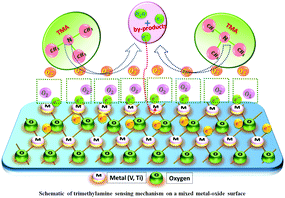Network mixed metal oxide (V4+ and Ti4+) nanostructures as potential material for the detection of trimethylamine†
Abstract
The highly sensitive and selective recognition of trimethylamine (TMA) in the environment plays an important role in preserving human health and air quality. There have been numerous attempts to utilize monooxides of VO2 and TiO2 thin films to detect several volatile vapours and gases; however, they lack the sensitivity and stability required for real-time use. Although VO2–TiO2 (VTO) mixed oxides are widely used due to their effective catalytic reduction properties, to date, their properties for chemical sensing have not been investigated. Also, due to the high demand for simple, low cost and highly sensitive TMA sensors, mixed oxides are attractive alternatives. Hence, for the first time, herein, we focused on exploring the possibility of using VTO mixed oxide thin films for TMA sensing based on their combined sensing capabilities. Herein, VTO thin films were deposited via the reactive co-sputtering technique, which demonstrated TMA sensing capability at room temperature (∼30 °C) in the concentration range of 5 to 300 ppm. It was found that the VTO mixed oxide thin film exhibited novel features with excellent TMA sensing properties and improved selectivity compared to that of the bare VO2 and TiO2 thin films. We demonstrated its versatility to detect TMA ((CH3)3N) in comparison to other vapours such as ammonia (NH3), acetone (C3H6O), dimethylamine ((CH3)2NH), ethanol (C2H5OH), formaldehyde (HCHO), isopropyl alcohol (C3H8O) and methanol (CH3OH) to prove its high sensitivity towards TMA. The effect of the percolation regime and sensing mechanism with band bending of the deposited thin films towards TMA vapours are discussed.



 Please wait while we load your content...
Please wait while we load your content...